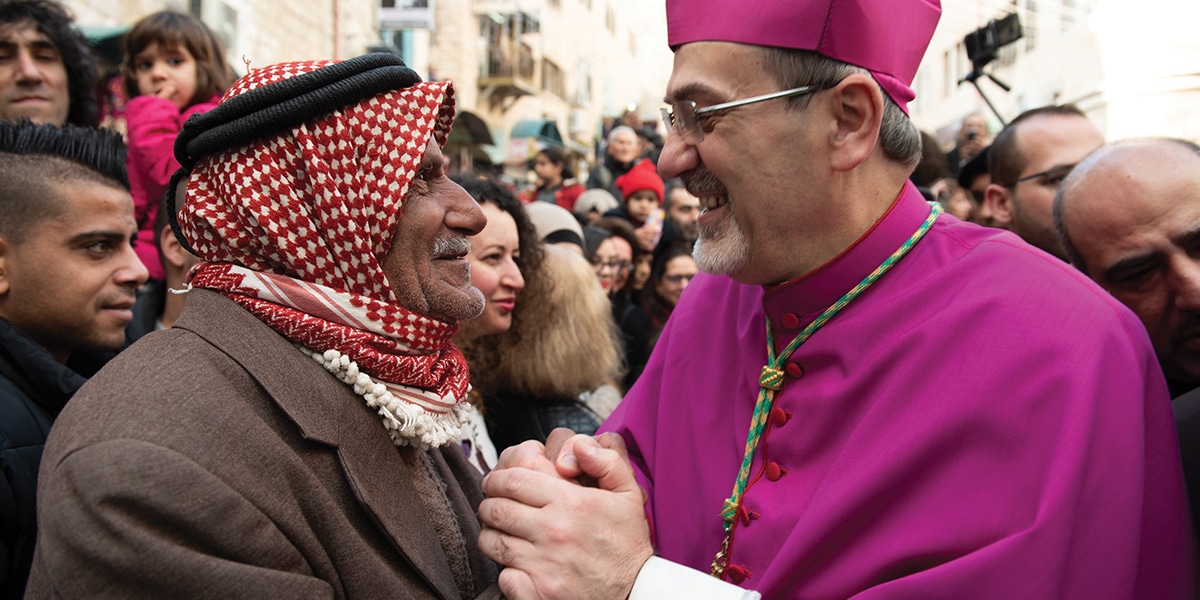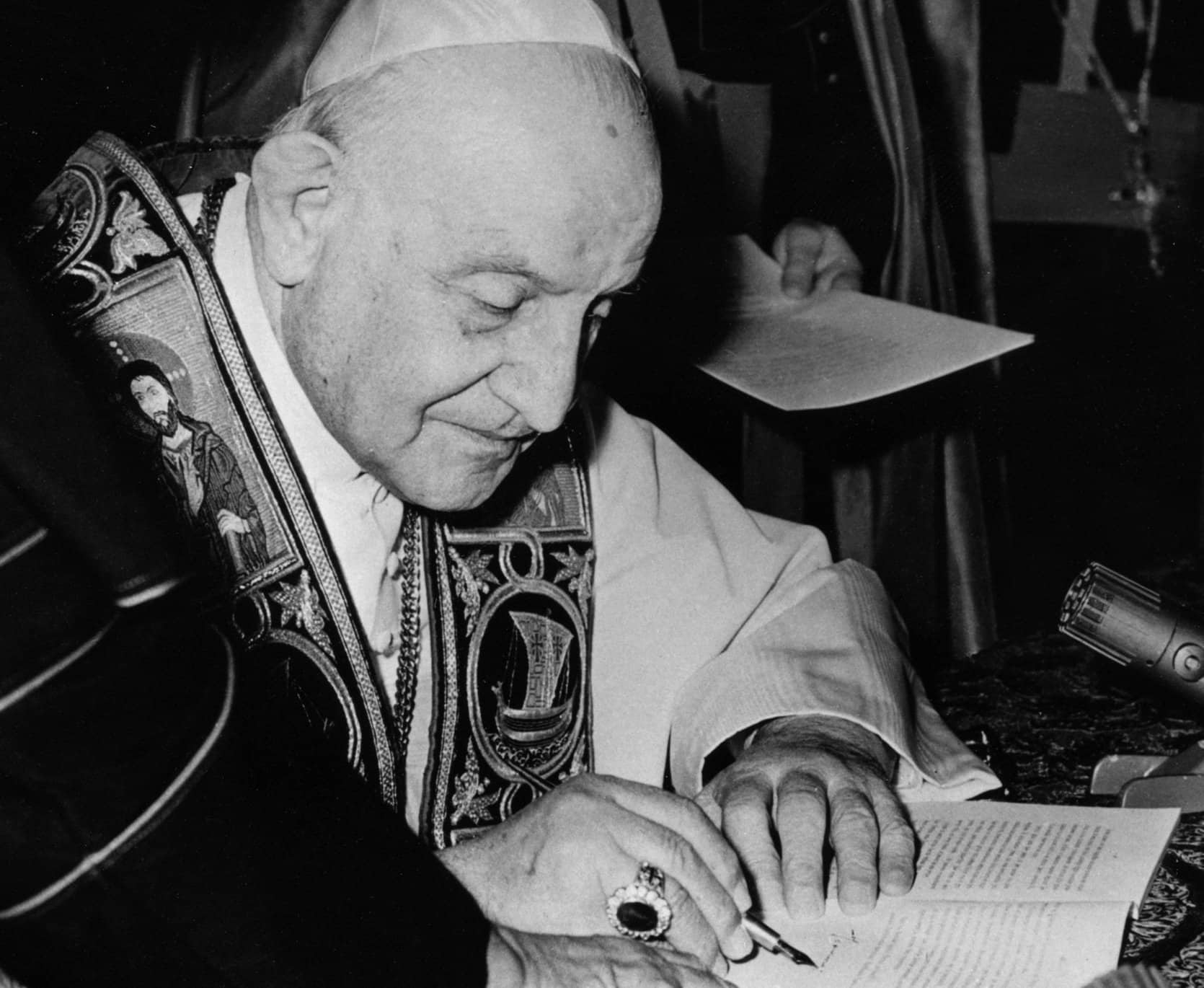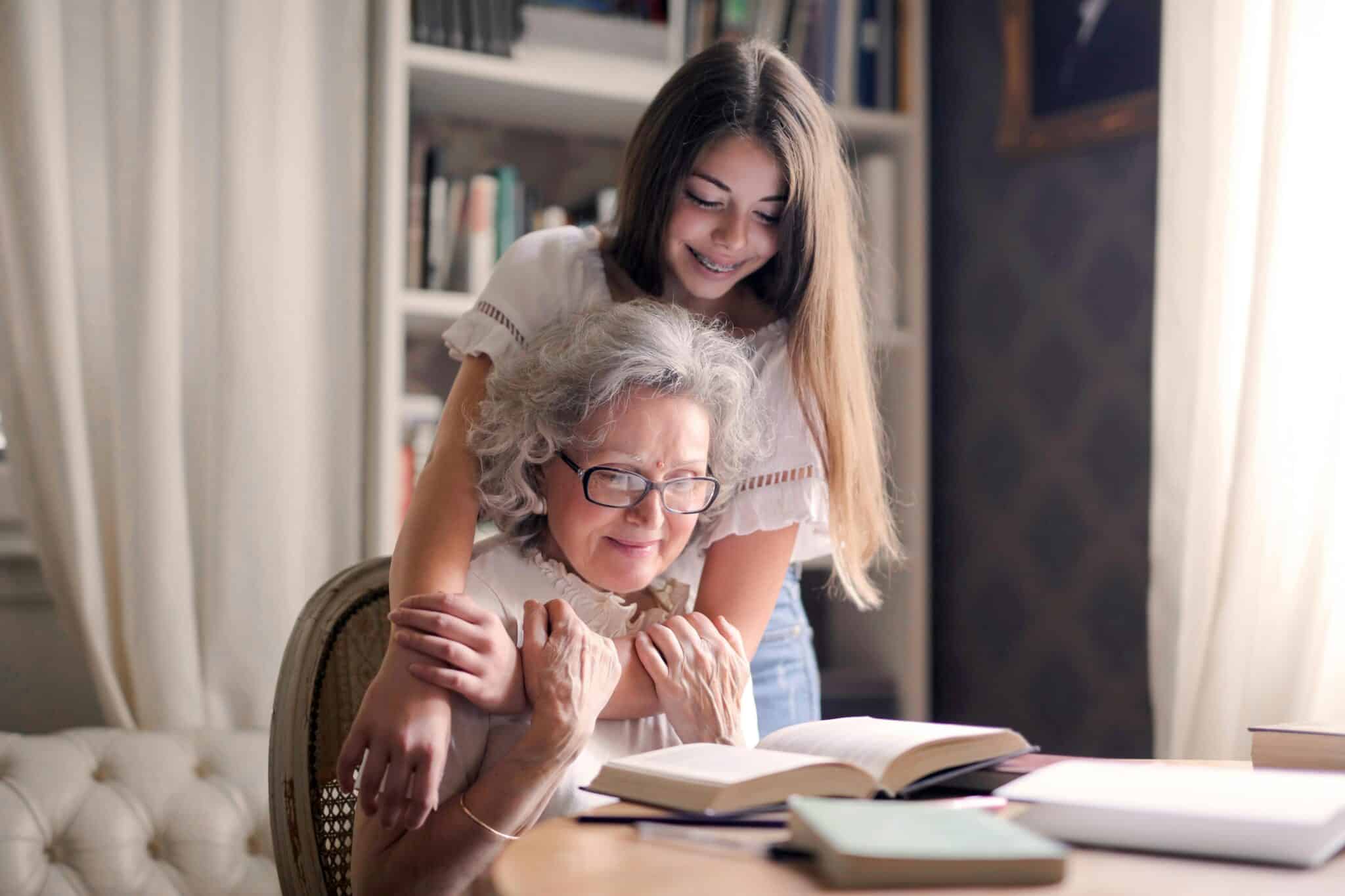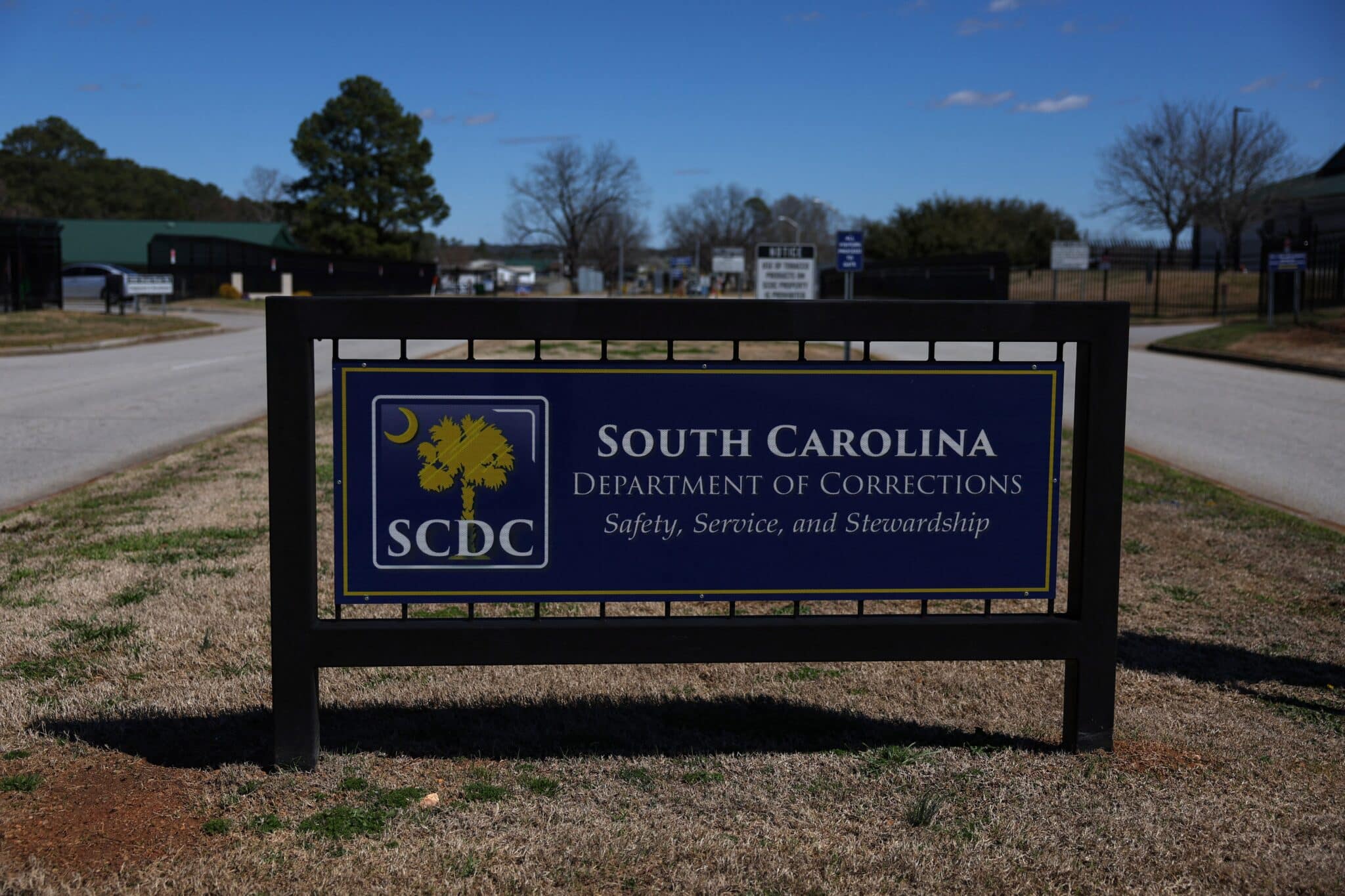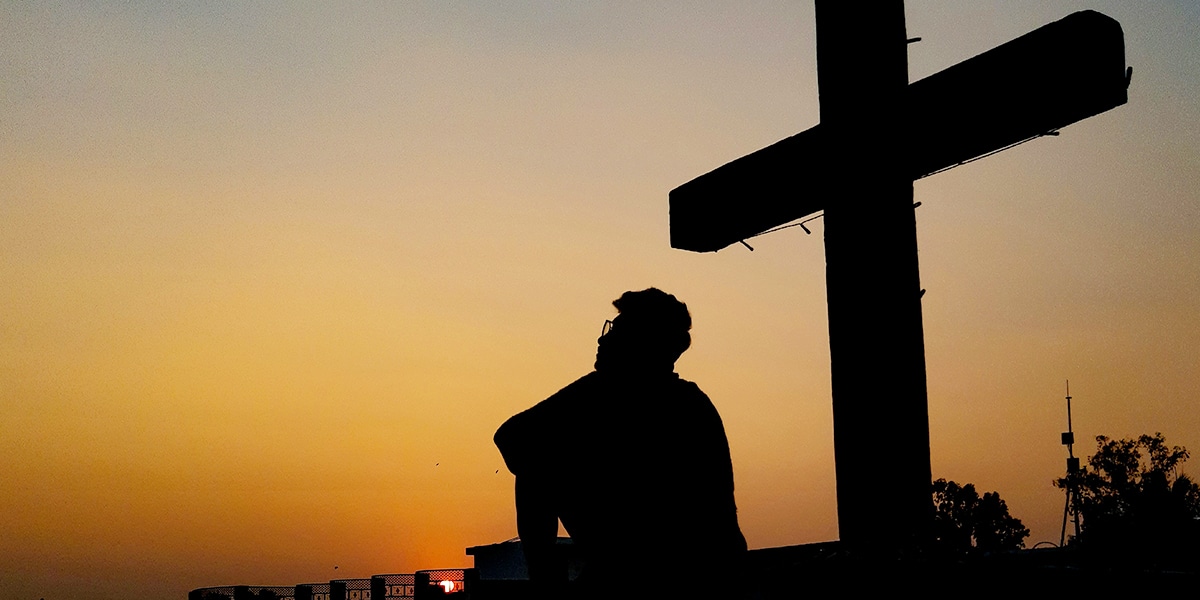Visiting the birthplace of Jesus makes an indelible mark on pilgrims, who describe the experience as profound, peaceful, and joyful.
A pilgrim travels to a holy place and recalls its sacred story. Perhaps no place in the world combines place and story better than Bethlehem in the Holy Land. For Christians and non-Christians alike over the centuries, the place where Jesus was born captures the imagination.
Its charm is thanks in no small part to St. Francis of Assisi, who created a “new Bethlehem” near the Italian hilltop town of Greccio in the 13th century. Countless Nativity scenes now bring the “little town of Bethlehem ” into the homes of believers.
“Growing up, my ideas of Christmas were a combination of the snowy Santa Claus scenes interspersed with some manger scenes,” says Lisa Sarah Larrabee, who was part of a Franciscan Holy Land pilgrimage last Christmas. “Being in Bethlehem felt more focused on the actual birth of Jesus than some of my holiday observances at home, which focus more on winter, gifts, and St. Nicholas’ legacy.”
For pilgrims, for the Franciscan friars who help to care for Bethlehem’s shrines, and for the Palestinian Christians who live there, the city is a mixture of beauty, discovery, mission, and challenge.
Franciscan Father Sandro Tomaševic, who welcomes pilgrims throughout the year, says that celebrating the birth of Jesus in Bethlehem is “a big grace and honor.” He adds, “For me as a Franciscan and as a priest, it truly means to live again the great event of the Incarnation, the birth of Christ.”
Like so many places in the Holy Land, Bethlehem confronts the pilgrim with layers of complexity. First-time visitors are surprised to find it’s only about a 30-minute bus ride from the center of Jerusalem. But the trip is complicated by the 120-mile separation barrier that divides the occupied West Bank from Israel. All traffic must pass through an Israeli military checkpoint. Beyond the wall, Bethlehem itself is under the limited control of the Palestinian Authority, whose police patrol the city. Foreign visitors enter and return with reasonable ease.
For Palestinian citizens, permits are necessary to enter Israel for work or study; some can only leave under very restrictive conditions, while others may encounter long delays in accessing their workplace or classroom. This political reality recalls for the visitor at Christmas the journey of Mary and Joseph—themselves outsiders to Bethlehem in Luke’s Nativity story—lacking a place to stay and subject to Roman authority.
‘A Continual Feast’
Christmas Eve in Bethlehem sets in motion a round of civil and liturgical events celebrated according to ancient traditions, governed by the agreement among Christian communities in the Holy Land known as the status quo.
Franciscan Father Benjamin Owusu guides pilgrims to Bethlehem. He points out that, to the people in Bethlehem, Christmas is “a continual feast, beginning from the first of December when preparations are taking place and then moves through the 24th and beyond . . . and it goes through early January, because the various communities have different dates for celebrating Christmas.”
Bethlehem is home to both Catholic (Latin) Christians and Orthodox Christians, as well as other Arab-speaking citizens, including Muslims. The season begins with “Latin” Christmas Eve on December 24 and concludes in mid-January with the Christmas and Epiphany celebrations of Greek and Armenian Orthodox Christians. In the ancient Church of the Nativity, three Christian communities—Greek Orthodox; Latin (Roman) Catholics, represented by the Franciscans; and Armenian Orthodox—celebrate the birth of Christ at fixed times and in various places.
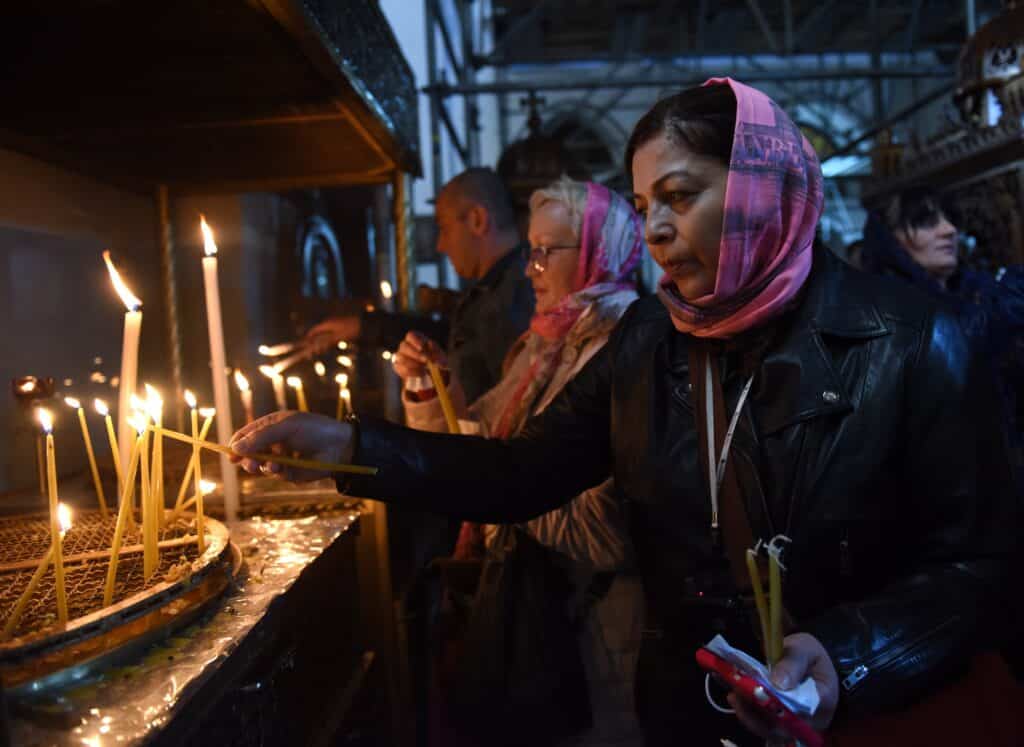
For Latin-rite Catholics, the schedule of the status quo determines Christmas celebrations by either the Latin patriarch (the archbishop for Latin-rite Catholics in Israel, Jordan, and Cyprus) or the Franciscan custos of the Holy Land (the minister provincial of the Friars Minor living throughout the Middle East). These liturgies take place in Bethlehem’s Church of the Nativity and the Church of St. Catherine of Alexandria, the parish church for Palestinian Catholics.
Latin-rite Catholics mark the start of the Christmas feast on the afternoon of Christmas Eve with the arrival of the Latin patriarch. The city’s mayor and other civic officials meet him at the Tomb of Rachel, located at an entrance in the separation wall. They escort the patriarch to Manger Square, where he is greeted by the Holy Land Franciscans and other clergy and residents of the city, as well as over 30 groups of Christian scouts, with marching bands. The friars lead him into the Church of the Nativity through the church’s small door—visitors literally bow at the waist to pass through, a reminder that the church was threatened in ancient times by plundering forces on horseback.
The procession passes into St. Catherine’s Church, which adjoins the Church of the Nativity. “We enter singing the ‘Te Deum,'” Father Ben says, “thanking God for a safe arrival. And then, shortly after a break, we begin the first vespers of Christmas.” Following this evening prayer, all process into the Church of the Nativity and down a series of steps into the grotto (cave) where Jesus was born.
All day, people gather just outside the church in Manger Square. Franciscan pilgrim Sue Forster recalls her excitement: “Walking in the footsteps of Our Lord over the Christmas pilgrimage, praying for our families back home, and placing their intentions at the different holy sites touched so many souls. It made the whole season reverent and joyful, away from the commercial rush and tension of being overly committed. Meeting other pilgrims from around the world made you realize how universal our Catholic Church is and [that] we are all one body.”
By long-standing tradition, the Franciscans invite civic authorities to a Christmas Eve dinner. Among the guests is the president of the Palestinian Authority, which governs portions of the West Bank surrounding Bethlehem, as well as the mayor of Bethlehem, ambassadors from different countries, and other officials.
‘For Christ Was Born of Mary’
Later that evening, midnight Mass is celebrated by the Latin patriarch in St. Catherine’s Church. In 2018, over 1,400 people attended. Franciscan Father Tomasz Dubiel, head of the Christian Information Center in Jerusalem, notes, “Most of the participants come from the United States, Italy, and France. Every year, we allocate a certain percentage of [free] tickets per country of origin.”
Since space is limited, those who cannot fit inside follow the Mass on video screens in nearby halls and in Manger Square—where a large Christmas tree is set up near a stage and choral groups from different parts of the world entertain through Christmas Eve and the next day.
The presider at the midnight Mass on Christmas 2018 was Archbishop Pierbattista Pizzaballa, serving as temporary apostolic administrator for the Latin Patriarchate. In his homily, he reminded all those present—civil and religious leaders as well as the faithful—of the meaning of Christmas in that sacred place:
“The birth of Christ in Bethlehem is . . . God’s step toward our land and our cities, and the invitation to go to Bethlehem, already addressed to the shepherds and the Magi, is repeated to us today, and from there to go to the extreme limits of the earth,” the archbishop said.
He added a challenge: “On this night, celebrating the birth of Christ in Bethlehem, we proclaim, together with the angels, love for this land, for its cities; we want to respond to the vocation received to be here as architects of peace, prophets of hope, convinced and convincing witnesses of sharing and dialogue.”
At the end of the Mass, a procession winds from St. Catherine’s into the Church of the Nativity, where the patriarch places a statue of the infant Jesus into the manger in the Grotto of the Nativity.
Although the Grotto is now richly adorned with marble, tapestries, and hanging lamps, a pilgrim can still appreciate the humility of Jesus’ birth. Franciscan pilgrim Elizabeth Awuor Omondi reflected on “God’s decision of when and where Jesus was to be born, inside a humble and simple setting, a cave used as an animal shed with livestock on a cold night in Bethlehem.” She took away from her pilgrimage” a clarion call to all to live a life imitating Jesus’ humility!”
When midnight Mass ends, according to Father Ben, the status quo permits the Franciscans to begin “a chain of celebrations in the Grotto till daybreak. . . . Each friar goes individually or with a group, and they continue every half hour.”
At the Milk Grotto, a Franciscan shrine that recalls Mary’s nursing of the infant Jesus, pilgrim Sue Forster had a special moment on Christmas Day. “I was so moved by seeing the statue of Our Blessed Mother nursing Jesus, and then the eucharistic chapel there, with the [contemplative] sisters adoring, was so wonderful,” she recalls. “We got lost in deep meditation there, my daughter and I, journaling our reflections on Mary’s model of motherhood.”
‘Shepherds in the Fields Nearby’
The Shepherds’ Field, a Franciscan shrine that commemorates the appearance of the angel host to shepherds, is about a 20-minute drive from Manger Square. The friars welcome Christmas pilgrims who cannot be accommodated elsewhere. Father Ben spent one Christmas Eve on duty there from 6 p.m. to 3 a.m., welcoming pilgrims and directing them to various altars throughout the shrine, where Mass was celebrated. It made for a long night— “Sleep is not in the vocabulary!” he laughs.
The Franciscan pilgrim group last December celebrated their Christmas Eve Mass at Shepherds’ Field. Lisa Larrabee sets the scene: “We were huddled in a small, simple cave with an altar and a manger scene. I got shivers to think that, 2,000 years ago, the shepherds may have roamed these very caves before bearing witness to Jesus’ first moments.”
Sue Forster agrees: “I remember thinking that was the most intimate and profound Christmas Eve Mass ever because there weren’t the throngs of people and the ‘production’ of the Christmas Eve Mass that our big parish at home does. So that intimate Mass was just glorious. We all were moved to tears.”
For Julie Elena Aliaga-Milos, that night “is engraved in my heart. The Mass was beautiful, and when we walked out, I felt that the environment had changed somehow: The moon was out, the air was lighter and crisper, and it felt so peaceful, although there were several groups gathered outside. I couldn’t help thinking how much more peaceful it must have been the night our Savior was born.”
A Spirit of Welcome Despite Hardships
Throughout Christmas, Manger Square is a gathering point for visitors. The many souvenir shops, Father Ben says, “stay open as long as you have people around. I think they do a 24-hour business because they cannot miss what is the greatest business day they have in the year!”
Lisa Larrabee remembers that “we were able to stroll through Manger Square and pick up some gifts or just sit on benches outside the church and absorb the scene and the occasion. It was fun to see others from all over the world taking pictures and savoring their time. I always felt safe there in terms of it being peaceful and orderly, and I felt welcomed.”
Jeries Kitlo emphasizes that hospitality is part of the Palestinian identity. “Bethlehem wouldn’t be Bethlehem if we were to close up on ourselves and just not allow other Christians or other people to come,” he says. “So we welcome people, and it doesn’t matter if they are Christian or Muslim. In Palestine, we just treat them like our own.”
Sina Pierret witnessed this spirit of welcome. “In Bethlehem, the people are friendly,” she says. “They’re kind. You can certainly see the challenges and the hardships that they endure because of the circumstances. And yet they are carving out a living. And they’re very dependent upon the pilgrims who come to visit and to share and to purchase their artwork, plus tips and so forth.” In the midst of the beauty of Christmas, she was aware of the challenges in the daily lives of the Palestinian citizens.
“You see their struggle. You see their poverty—poverty materially or perhaps in resources—but they certainly are rich spiritually.”
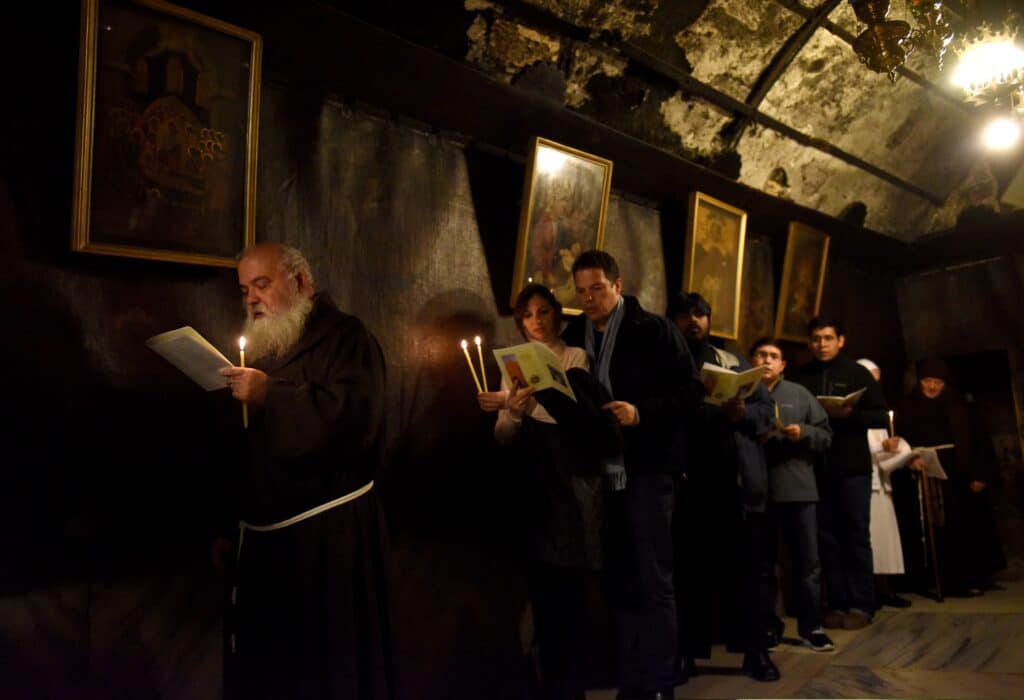
Amany Abu Awad, who lives in the neighboring village of Beit Jala, is a Palestinian Christian woman in her mid-20s. For her, the Christmas story is also a reminder of what remains unfulfilled for her people.
“Palestine is the Holy Land, and Bethlehem is the birthplace of Jesus Christ, the king of peace. Yet for 70 years, Palestinians haven’t lived a single day of peace,” she says. “On a daily basis, we experience humiliation, dehumanization, and violation of human rights.”
Young Palestinians face unemployment or underemployment, forcing them to emigrate seeking better opportunities and a decent life. She dreams of a day “when the occupation ends [and] Palestinians who have emigrated, especially young people, will return to Palestine.”
Amany hopes that pilgrims who visit Bethlehem will become “the voice of the voiceless and break the silence about the Palestinian reality. For this reason, it is really important that they come to Palestine and witness the daily struggles of Palestinians under occupation and the injustices we face.”
A Journey Every Christian Should Consider
Christmas pilgrims sometimes put off the trip due to safety concerns. Jeries Kitlo wants those thinking of a pilgrimage to Bethlehem and the rest of the Holy Land not to base their reluctance on “images and videos on media [where] people claim that it’s dangerous.” He cautions them not to allow exaggerated fears to “keep you from visiting such a holy place in our faith.”
Another pilgrim, Caterina Anna Gliosca, agrees. “Most of those close to me—family and friends—worried,” she says. “I told them I felt safe, secure, protected, at peace, calm.” She urges all to visit: “It makes the Bible come to life. I feel I have a better knowledge of where I am from.”
Visiting the Grotto of the Nativity on Christmas Day, Julie Aliaga-Milos experienced one of the blessings of pilgrimage—the spirit of community within the pilgrim group. “We waited in line for a long time,” she recalls. “I have arthritis in my knees, and it was very hard standing up for so long. As we approached the stairs to go down to the birth site, I wasn’t sure if I could manage the few steps on my own. As if on cue, two fellow pilgrims grabbed me by each arm, so I was able to go down. Bless their hearts!
“As I touched the blessed site, something deep overtook me, and I felt so humbled by it and unworthy to be there. I could not help it and broke down in tears as I came out of there. Another lady in the group, seeing me in this way, consoled me with sweet words until I was able to control my tears.”
Lisa Larrabee sums up her Christmas in Bethlehem: “It put Christmas in a clearer perspective and focused me on the story of Jesus more so than the story of St. Nicholas. For example, just experiencing a warm, dry Christmas in a region marked by deserts and warm-climate foliage and plants was a stark reminder of how the original Christmas may have occurred, separate from the wintry images I had grown up with.
“I also got to get a deeper understanding of the Holy Family’s journey from Nazareth to Bethlehem. There was a simplicity and purity to this Christmas, as it was focused on the religious aspects and I wasn’t as distracted by the other trappings of Christmas such as cooking, parties, and gift exchanges. Those are all a nice part of Christmas as well, but this put the events around Jesus’ birth into a sharper focus, which I think I will always hold on to.”


